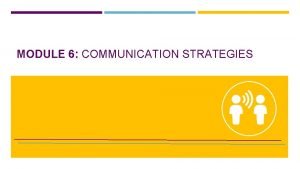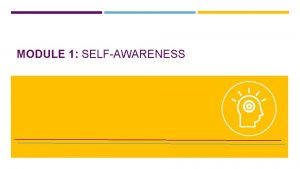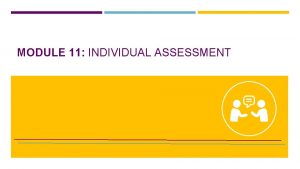VDK Module Outline What is the VDK Why
















- Slides: 16

VDK Module Outline • What is the VDK? • Why Do We Need a Kernel? • VDK Concepts and Features • How to Create a Project with VDK support • Debug Capabilities • Summary/Conclusion Copyright © Avnet, Inc. , Analog Devices, Inc. All rights reserved.

What is the VDK? • The Visual DSP Kernel is a pre-emptive kernel designed to run efficiently on Analog Devices family processors • Included with Visual. DSP++ development tools • No NRE or royalties associated with VDK Copyright © Avnet, Inc. , Analog Devices, Inc. All rights reserved.

Why do we need a kernel? • A simple application that does only one task may not need a kernel – i. e. ) Blind processing of a super loop • If you have more than one task, an application could be structured in a couple of ways – Respond to an event • Events change execution state – Assign tasks a given priority and execute high priority tasks more often • These approaches get difficult when – You need to preserve the state of a task – Low priority tasks may steal processing time longer than anticipated Copyright © Avnet, Inc. , Analog Devices, Inc. All rights reserved.

What does a kernel give you? • Automatic preservation of task/system state • Assign a scheduling method to tasks • Provides synchronization abilities • Frees architect from having to design ‘control code’ Copyright © Avnet, Inc. , Analog Devices, Inc. All rights reserved.

VDK Domain Concepts • Application code executes in one of two domains – 1 Thread Domain – 2 Interrupt Domain • Applications and algorithms execute in the thread domain under control of the VDK Kernel • Interrupts execute outside this domain and priority is implemented in hardware – Thread execution is halted while in the interrupt domain • Device drivers are a bridge between the two domains Copyright © Avnet, Inc. , Analog Devices, Inc. All rights reserved.

More VDK Concepts • Threads – A segment of code and it’s related variables/data – Each thread has its own stack and executes in supervisor mode • Interrupts – Priority based in hardware • Strongly recommend writing in assembly but C/C++ is supported • Signals – Semaphores, Events, Device Flags, and Messages – Used to synchronize activity • Device Drivers – Threads do not communicate with hardware directly – Hide the details of the hardware Copyright © Avnet, Inc. , Analog Devices, Inc. All rights reserved.

Threads • Thread types defined at project creation • Each thread has a unique Thread. ID • Each thread has its own stack – Programmers responsibility not to overflow • The size of heap for stack and thread data can be specified Copyright © Avnet, Inc. , Analog Devices, Inc. All rights reserved.

Semaphores • Signals are used to synchronize thread activity – A semaphore is a token that threads can post or acquire – i. e. ) relay race – second runner can not run until it has the baton • Semaphores can be periodic – allows given tasks to be scheduled on a fixed interval Copyright © Avnet, Inc. , Analog Devices, Inc. All rights reserved.

Events and Event Bits • Events are used to synchronize thread activity to the system – Used to convey various system states to threads • Similar to semaphores but can convey several combined system states at once Copyright © Avnet, Inc. , Analog Devices, Inc. All rights reserved.

Messages • Inter-thread communication – Transfer information between threads • i. e. ) Thread A sends some data for processing to Thread B • Application views single and multiprocessor systems the same Copyright © Avnet, Inc. , Analog Devices, Inc. All rights reserved.

Interrupts • Execute using hardware priorities – Spend as little time as necessary and only do the minimal processing required in ISR • Any registers used by an ISR must be saved and restored • ISRs can be written in assembly, C or C++ – C/C++ not recommended but included for flexibility Copyright © Avnet, Inc. , Analog Devices, Inc. All rights reserved.

Device Drivers • Device drivers bridge the gap between the thread and interrupt domains – How threads communicate with hardware – Provides a black box view to the application • A device driver is a single function with multiple entry points – Initialization – Activation – Open – Close – Sync. Read – Sync. Write – IOCtl Copyright © Avnet, Inc. , Analog Devices, Inc. All rights reserved.

Creating a Project using VDK • VDK support is added from the project wizard in Visual DSP++ • Visual DSP++ creates all the necessary project files and skeleton code Copyright © Avnet, Inc. , Analog Devices, Inc. All rights reserved.

The System Node System Control Thread Blackfin Threads Configuration Copyright © Avnet, Inc. , Analog Devices, Inc. All rights reserved.

Debug Assistance • Integrated in to Visual DSP++ • VDK Status window – State of each object, active thread, resource management, etc • VDK History window – Graphical display of system events – Useful when used with Trigger points Copyright © Avnet, Inc. , Analog Devices, Inc. All rights reserved.

VDK Summary • Provides a comprehensive set of services reducing the need to create your own control code • Allows for rapid prototype of system • Easy to move applications/algorithms across ADI processor families • Well integrated with the IDDE for efficient editing and debug Copyright © Avnet, Inc. , Analog Devices, Inc. All rights reserved.
 Andreas carlsson bye bye bye
Andreas carlsson bye bye bye Dont ask
Dont ask C device module module 1
C device module module 1 Topic sentence sandwich
Topic sentence sandwich Hình ảnh bộ gõ cơ thể búng tay
Hình ảnh bộ gõ cơ thể búng tay Lp html
Lp html Bổ thể
Bổ thể Tỉ lệ cơ thể trẻ em
Tỉ lệ cơ thể trẻ em Chó sói
Chó sói Tư thế worm breton
Tư thế worm breton Alleluia hat len nguoi oi
Alleluia hat len nguoi oi Kể tên các môn thể thao
Kể tên các môn thể thao Thế nào là hệ số cao nhất
Thế nào là hệ số cao nhất Các châu lục và đại dương trên thế giới
Các châu lục và đại dương trên thế giới Công thức tính thế năng
Công thức tính thế năng Trời xanh đây là của chúng ta thể thơ
Trời xanh đây là của chúng ta thể thơ Mật thư anh em như thể tay chân
Mật thư anh em như thể tay chân































